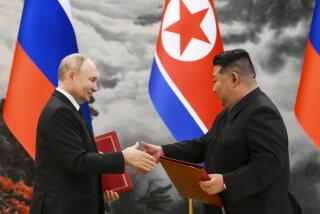South Korea opened fire at tense border zone. Turns out incursion was North Korean balloons

South Korean soldiers firing more than 90 machine gun rounds in the air at what turned out to be North Korean balloons underscores the tension along the country’s border. (May 24, 2017) (Sign up for our free video newsletter here)
Reporting from SEOUL — The slow-moving, unidentified object flying over South Korea’s border on Tuesday afternoon caused so much concern that soldiers issued loudspeaker warnings and ultimately fired more than 90 machine gun rounds in the air.
What first seemed like a provocative North Korean military incursion — perhaps a drone flight over the two countries’ highly secured border — turned out to be much more innocuous, the South Korean military said Wednesday.
After studying radar evidence and thermal imagery, those military officials now believe the incident was sparked by a group of large North Korean balloons — likely an effort to drop propaganda leaflets on the rogue state’s ideological adversaries in the South.
Though less serious than first reported, the incident underscores the heightened tensions along the border, and the region generally. That’s because of the North’s continued advancement as a nuclear state and its increasing technical prowess in developing missiles that can deliver warheads.
On Tuesday, though, the payload was obviously less threatening — a fact that emerged many hours after military officials fired shots and later told the news media about the incident.
South Korean military officials, closely allied with American forces, said Wednesday that their troops hadn’t overreacted to the potential provocation, which to them was reminiscent of a drone flight 18 months ago by the North that also prompted gunfire.
“We prepared for the worst-case scenario of the object being an enemy drone,” said Moon Sang-gyun, a South Korean military spokesman. “We prepared thoroughly according to procedure until the object was clearly identified.”
The governments of both nations, still locked in a decades-old and unsteady truce after Korean War, on occasion send propaganda messages across their shared border. The South has used massive loudspeakers to announce propaganda to the North’s troops and residents in its southern villages, for example.
But South Korean officials said the wind direction and the balloons’ shape in this case pointed to an effort by the North to most likely deliver anti-democracy messages.
The North’s past propaganda messages, which fall as balloons lose altitude, have sometimes landed atop high-rise apartments in Seoul — and even around the vast and leafy American military headquarters in the capital city’s center.
The South’s armed response, in some ways, reflects current tensions.
The North has conducted more than 60 missile tests since its young, dynastic ruler, Kim Jong Un, took power in late 2011. That includes more than two dozen missile tests and two underground nuclear detonations in the last 18 months.
The latest missile test, of a medium-range device that raised eyebrows among security analysts for its advanced fuel capability and potential distance, came on Sunday. The North had already conducted another missile test just a week before.
All of these activities — considered “provocations” by American and South Korean officials — violate a series of United Nations Security Council resolutions.
The council Monday issued a strong statement of condemnation, saying more potential sanctions against the North Korean regime might be coming.
The condemnation was announced after the North’s state media said the apparent success of its most-recent Pukguksong-2 missile test had prompted the leader to order their mass production.
More than half of the launches under Kim’s tenure have been with short-range missiles, which have a range of roughly 600 miles, according to data collected by the Center for Strategic and International Studies, a Washington-based bipartisan research group.
Seoul, a metro area of 20 million people, is roughly 120 miles from Pyongyang, and much closer to the North’s border, making it a target for more conventional weapons, like artillery. U.S. forces here have installed a new defense system designed to protect other parts of South Korea from missiles.
The number of tests of medium-range missiles — which in theory could fly 1,500 miles, and perhaps be used against American targets elsewhere in Asia — has been on the rise, however.
The North’s recent behavior, coming immediately after the election of a new South Korean president who has signaled an intention to improve relations between the two countries, is puzzling, some say.
That, of course, is another hallmark of the North’s regimes, including under the previous leader, Kim Jong Il.
“I’m not sure what to make of this, honestly,” said Robert Kelly, a political science professor at Pusan National University in South Korea who also runs a blog about security in Asia.
Security experts, of course, worry most about the North developing an intercontinental ballistic missile capable of reaching the American mainland or other distant foe with a nuclear warhead.
That’s a challenging but not impossible goal for the regime, which is somewhat isolated technologically, slowing its progress. The regime faces a learning curve building not just the multistage vehicle for launching a warhead far into the atmosphere, but also the ability for it to hurtle back to Earth safely and accurately.
Such a capability would vastly improve the regime’s hold on power internally and externally — and its ability to negotiate with the international community on economic issues, like sanctions.
“They are going to sprint toward it regardless, because it will vastly improve their bargaining position,” Kelly said.
Kelly said he had no clear answers for what prompts the regime, which at times seems somewhat decentralized militarily, to try something like a balloon launch.
“The balloon ... might just be some random act by a local commander trying to impress his superiors,” he said.
Stiles is a special correspondent.
More to Read
Sign up for Essential California
The most important California stories and recommendations in your inbox every morning.
You may occasionally receive promotional content from the Los Angeles Times.











